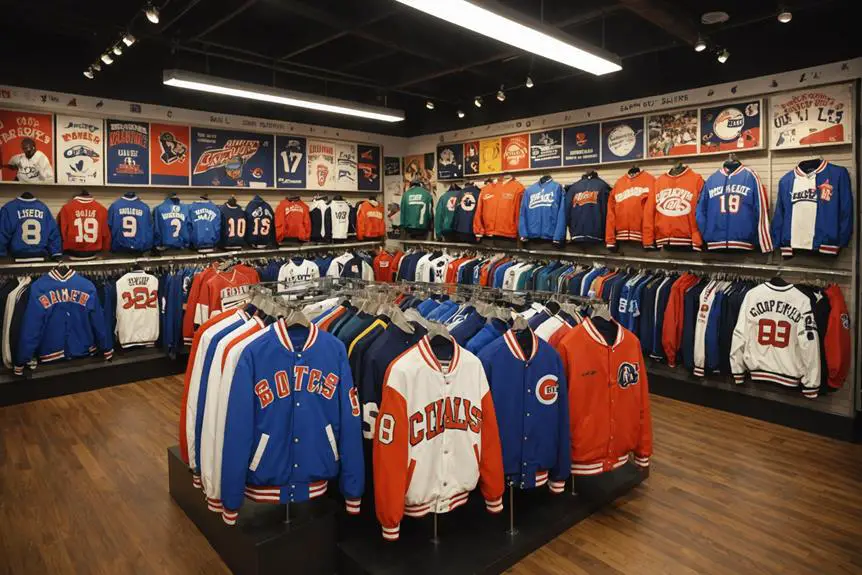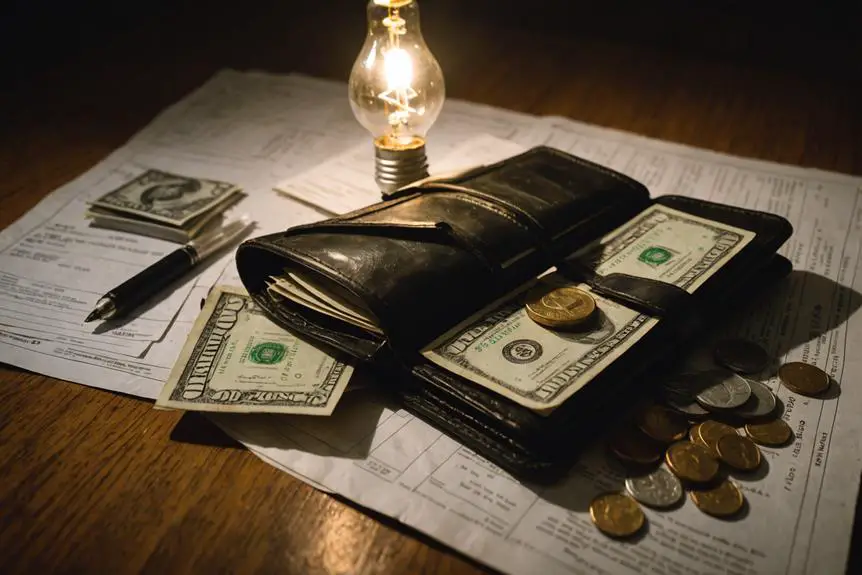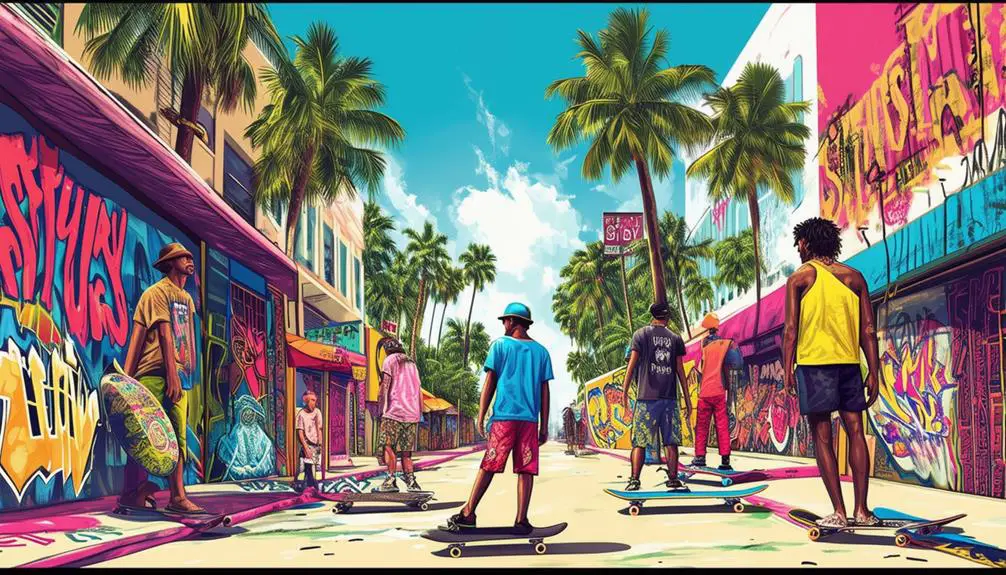Starter's evolution since its 1971 founding by David Beckerman showcases the complex dynamics of fashion brand development. Initially focusing on athletic uniforms, it expanded into major sports licensing by the '90s, becoming a staple in youth culture with its iconic jackets that blended sport and style. However, financial struggles and operational challenges led to bankruptcy in 1999. Despite a tumultuous history, including acquisitions and product relaunches, Starter continues to innovate with collaborations and sustainable practices, ensuring relevance in the ever-evolving fashion landscape. Understanding these pivotal moments not only frames the brand's history but also highlights its resilience in the competitive sports fashion market. There's much more to explore about its journey.
Company Origins and Growth

Starter's origins trace back to 1971, when David Beckerman established the brand in New Haven, Connecticut, primarily focusing on high school athletic uniforms and jackets. This initial niche laid the groundwork for future growth. In 1976, Starter secured its first major licensing agreement with the New York Mets, which marked a pivotal moment in the brand's trajectory. Over the next few years, partnerships with the NBA and NHL followed, and by 1983, Starter had also entered the NFL market.
The brand's popularity soared, particularly among youth, as it became synonymous with stylish satin jackets. By 1991, Starter's annual sales reached an impressive $200 million, establishing it as a cultural phenomenon. In 1993, a public offering raised $98 million, fueling further expansion into Europe and the launch of the Brand Starter line, which contributed to sales jumping to $356 million within two years.
However, despite these successes, the late 1990s brought financial challenges. Starter struggled to maintain its momentum, and in 1999, the company filed for Chapter 11 bankruptcy, marking a significant downturn in its history within the competitive sports apparel market.
Rise to Cultural Icon
In the 1990s, Starter jackets burst onto the scene as a defining element of youth culture and sports fandom, transforming from mere athletic wear into a coveted fashion statement. This cultural phenomenon generated $200 million in annual sales by 1991, making Starter a staple among young sports fans. The brand's aggressive marketing strategies, including collaborations with influential hip-hop artists like Chuck D and Diddy, positioned Starter jackets as a status symbol within urban fashion.
The slogan "Look for the Star!" reinforced Starter's brand identity, creating an emotional connection that resonated with fans and contributed to widespread recognition. However, the intense demand for these jackets also led to tragic incidents of theft and violence, illustrating the brand's profound impact on youth culture and streetwear trends.
Despite a decline in popularity by the late 1990s, Starter's legacy remains, serving as a nostalgic symbol of 80s and 90s streetwear culture. Today, vintage pieces are still highly sought after by collectors, showcasing the enduring influence of Starter jackets in the fashion landscape. As you reflect on this era, you'll appreciate how Starter shaped youth identity and urban style.
Expansion and Product Offerings

As Starter ventured into the 1990s, it broadened its product offerings to include a diverse array of sportswear that catered to both men and women. This expansion was marked by the introduction of hoodies, sweatpants, jerseys, jackets, and activewear, which appealed to a growing consumer base seeking stylish yet functional athletic apparel. Securing licensing agreements with major sports leagues, including the NFL, NBA, and NHL, allowed Starter to produce and sell officially branded merchandise, considerably enhancing its product range.
Marketing Strategies and Trends
With a solid foundation established through its expanded product offerings, Starter turned its focus to innovative marketing strategies to solidify its presence in the competitive sportswear market of the 1990s. The brand adopted aggressive marketing tactics, leveraging celebrity endorsements and collaborations with hip-hop artists to enhance brand visibility and connect deeply with youth culture.
Starter became synonymous with licensed sports apparel, highlighted by its memorable slogan, "Look for the Star!" This slogan reinforced its identity and sports fandom connection. Additionally, nostalgia-driven retro product lines and limited-edition releases generated significant buzz, appealing to collectors and sports enthusiasts alike.
The following table summarizes Starter's key marketing strategies:
| Strategy | Description |
|---|---|
| Celebrity Endorsements | Boosted appeal through high-profile athletes |
| Exclusive Licensing Agreements | Partnered with NFL, NBA, and MLB for credibility |
| Nostalgia-driven Releases | Revived classic styles to attract older fans |
| Limited-edition Releases | Created urgency and exclusivity among consumers |
| Social Media Campaigns | Engaged younger audiences through digital platforms |
Today, Starter continues to evolve its marketing strategies through social media campaigns and influencer collaborations, maintaining its relevance in sportswear culture.
Financial Struggles and Challenges

The financial landscape for Starter in the 1990s became increasingly tumultuous, culminating in a series of challenges that threatened the brand's viability. Despite a promising 23% increase in Q1 sales, Starter reported a $2.2 million loss in Q2 1994, indicating underlying financial struggles. By April 19, 1999, the company declared Chapter 11 bankruptcy, burdened by over $120 million in debt and declining sales attributed to fierce competition and market saturation.
The impact of external factors, such as Major League Baseball's 1994 strike and the NHL lockout, further exacerbated the situation. These events diminished demand for licensed apparel, a significant revenue source for Starter. Additionally, the late 1980s brought misfortunes, including a devastating warehouse fire and severe weather events, which contributed to its financial decline.
After bankruptcy, Starter faced multiple ownership changes that hindered its ability to regain market position. This instability made it challenging to renew crucial license agreements, which directly affected product availability. Ultimately, these compounded financial challenges left Starter struggling to maintain its once-prominent role in the competitive sportswear landscape.
Licensing Breakthroughs and Impact
Starter's licensing breakthroughs revolutionized the sports apparel industry and set a high bar for brand partnerships. By securing exclusive rights to produce NFL sideline jackets and using the NFL shield logo, Starter achieved staggering sales of over $2 billion in 1991. This milestone underscored the brand's impact on merchandise and fan culture. In the late 1970s, Starter became one of the first brands to establish a thorough licensing agreement with the NBA, allowing it to produce officially licensed apparel for the league.
The partnership with the New York Mets in 1976 marked Starter's entry into professional sports licensing, setting a precedent for collaboration between apparel brands and sports teams. These strategic partnerships not only enhanced Starter's branding but also influenced how teams and leagues approached fan merchandise. In 1991, the brand's innovative licensing strategies led to $200 million in annual sales, showcasing its dominance in the market. Overall, Starter's early licensing agreements laid a vital foundation for the evolution of the sports apparel industry, demonstrating the powerful synergy between licensing, branding, and sales that continues to shape the market today.
Decline and Restructuring Efforts

Financial turbulence marked a notable chapter in Starter's history, revealing vulnerabilities that stemmed from various operational challenges. Despite a 23% revenue increase in Q1 1994, Starter faced a $2.2 million loss in Q2, attributed to vendor delays and rising costs. By 1997, Starter became one of three NBA uniform suppliers, yet financial decline persisted, leading to its Chapter 11 bankruptcy filing on April 19, 1999, with over $120 million in debt. Increasing competition and declining sales, exacerbated by labor disputes in major leagues, greatly contributed to this downturn.
Following bankruptcy, Starter sought restructuring under the leadership of founder David Beckerman. However, this shift was fraught with difficulties, particularly in renewing licensing agreements, which were essential for revitalizing the brand. The acquisition of Starter by Official Starter Properties in 1999, followed by Nike in 2004, aimed to stabilize the brand's presence in professional sports. While Starter attempted a comeback by relaunching its satin and pullover jackets in 2013, and securing a role as the official supplier for the Alliance of American Football in 2018, the league's folding in 2019 illustrated the ongoing challenges in a competitive landscape.
Recent Developments and Collaborations
Amidst a competitive landscape, recent developments at Starter highlight a strategic pivot aimed at revitalizing the brand and expanding its market presence. In November 2019, Starter announced a collaboration with Coca-Cola to create branded apparel, greatly enhancing its product offerings. This partnership not only broadened its appeal but also showcased Starter's commitment to merging iconic brands.
To cater to a diverse audience, Starter has expanded its product lines to include compression gear, sneakers, and logo-less jackets, diversifying its athletic apparel range. The brand has further focused on collegiate-inspired collections through partnerships with various institutions, effectively targeting its youthful demographic.
Moreover, Starter is increasingly prioritizing sustainability in its manufacturing processes, aligning with modern consumer values. This focus on eco-friendly practices enhances its appeal among environmentally conscious shoppers. Additionally, Starter is exploring collaborations with emerging fashion designers to refresh its product line and maintain relevance in a rapidly evolving market. By embracing these strategic partnerships and innovations, Starter aims to solidify its position as a leader in the athletic apparel sector while attracting the modern consumer looking for style, performance, and sustainability.
Future Vision and Strategic Focus

In today's fast-paced retail environment, companies like Starter are reimagining their futures by honing in on strategic focuses that align with market demands and consumer values. To enhance brand visibility and appeal to a diverse audience, Starter is expanding its product offerings and emphasizing sustainability in its manufacturing processes. Here's how the company is shaping its future:
- Diversifying Product Lines: Introducing compression gear and sneakers alongside logo-less jackets.
- Emphasizing Sustainability: Committing to environmentally-friendly manufacturing practices.
- Forming Strategic Partnerships: Collaborating with emerging fashion designers to revitalize its image.
- Enhancing Online Shopping: Improving the digital experience to attract younger consumers.
- Targeting International Markets: Leveraging nostalgic appeal to capture new customer segments globally.
Frequently Asked Questions
What Is the History of Car Starter?
You'll find the car starter's evolution began in the early 1900s, with significant advancements like Kettering's 1912 design. Modern starters use a solenoid system, typically lasting 100,000 to 150,000 miles before needing replacement.
Who Created the Starter?
You might find that the starter, an essential component in automobiles, was invented by Charles Kettering in 1912. His innovation revolutionized vehicle ignition, considerably enhancing convenience and reliability for drivers everywhere.
Why Did Starter Brand Fall Off?
Starter fell off due to financial struggles from market saturation, negative publicity linked to violence, and ownership changes that severed consumer connections. These factors diminished its appeal, leading to a decline in brand presence and loyalty.
Why Did Starter Go Out of Business?
Starter went out of business due to overwhelming debt, declining sales from market saturation, reputational damage from violence associated with its products, and mismanagement following its shift to a publicly traded company.





Your article helped me a lot, is there any more related content? Thanks!
Hurrah! In the end I got a weblog from where I be capable of actually take useful data
regarding my study and knowledge.